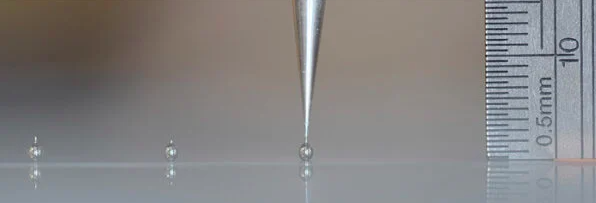Researchers at the University of Minnesota Manufacture the First 3D Printed Flexible OLED Display

A team of researchers at the University of Minnesota have created the first 3D printed, flexible organic light-emitting diode (OLED) displays, measuring 3.8 cm by 3.8 cm with 64 pixels. The project is particularly interesting as it is a flexible display that could be used to fold smartphone or TV screens, all at a more affordable cost. Two different additive manufacturing technologies and a custom printer were used to produce it.
Organic light-emitting diodes rely on organic materials to emit light, unlike LCDs which use inorganic crystalline semiconductors. OLEDs are therefore an alternative to LCDs and have several interesting features: better energy efficiency as they do not require backlighting, high contrast ratio, mechanical flexibility, wider viewing angle and better resistance to breakage. However, 3D printing of such diodes has so far presented many challenges. OLED display technology is based on the conversion of electricity into light using a layer of organic material. Creating this layer is difficult because it requires perfect uniformity, which is more complicated to achieve through additive manufacturing. Additionally, polymer-metal bonds made using 3D printing are also more unstable.

An extrusion method and a spray process were used (photo credits: McAlpine Group, University of Minnesota)
Six layers 3D printed to form the OLED display
The team used two 3D printing processes to overcome these challenges and create the six layers of the display. Using an extrusion machine, they created the electrodes, insulation, interconnects and encapsulation. The same 3D printer was then used to create the layers using a spray printing process. Specifically, the layers were successively printed from various materials, depending on the function of the layer in question. For example, the first layer was deposited on a flexible PET film and silver nanoparticles; the fourth layer is a silicone layer covering the underlying conductive materials. Finally, the device was encapsulated with a polymer cast in an extrusion-printed silicone mold.

The screen is composed of 6 different layers (photo credits: McAlpine Group, University of Minnesota
“Overall, the lack of uniformity in the active layers caused large variations in light emission across the active regions within the same batch of devices, signifying the need for alternatives to extrusion printing for the fabrication of large-scale display devices. Therefore, we exploited a spray printing method to deposit MDMO-PPV to improve the uniformity of the active layers. The spray nozzle was integrated into our printing system, whereby the ink was atomized at the orifice when a high relative speed was created between the near-static ink and the pressurized sheath gas. The atomized droplets had diameters in the range of 30 to 50 μm and rapidly evaporated after impacting the substrate, resulting in suppressed mass transport in the lateral direction. In the spray-printed active region, microdroplets were uniformly distributed across the target area and a substantial reduction in the thickness variation was observed,” the team explained. The result was a flexible prototype measuring 3.8 centimeters on a side, with 64 pixels capable of displaying light.
The researchers point out that the machine used was custom-developed and therefore incorporates different nozzles that are changed depending on the layer to be deposited. They are mounted on a robotic gantry system. In total, the machine would cost about the same as a Tesla Model S. Still the printing method should evolve and become more widespread, according to Michael McAlpine, senior lecturer in the Department of Mechanical Engineering at the University of Minnesota, who noted “OLED displays are usually produced in big, expensive, ultra-clean fabrication facilities. This is something that we actually manufactured in the lab, and it is not hard to imagine that you could translate this to printing all kinds of displays ourselves at home or on the go within just a few years, on a small portable printer.”
While we wait to see what the future holds for display technologies, you can find the full study HERE. What are your thoughts on using additive manufacturing to produce OLED displays? Let us know in a comment below or on our Linkedin, Facebook, and Twitter pages! Don’t forget to sign up for our free weekly Newsletter here, the latest 3D printing news straight to your inbox! You can also find all our videos on our YouTube channel.
*Cover Photo Credits: McAlpine Group, University of Minnesota







